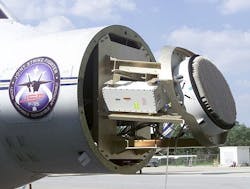Colorado Engineering to develop GPGPU-based embedded computing for F-35 radar signal processing
Officials of the Naval Air Warfare Center Aircraft Division in Lakehurst, N.J., announced a $3 million contract to Colorado Engineering last week to design, fabricate and test graphics processing units (GPUs) paired with a supporting processor infrastructure that are compatible with the F-35's Block 4 radar.
The planned Block 4 upgrades to the F-35 are expected to include adding a wide-area high-resolution synthetic aperture radar (SAR) mode to the Northrop Grumman APG-81 active electronically scanned array (AESA) radar. The F-35 Block 4 upgrades will be broken into two increments; Block 4A in 2021 and Block 4B in 2023.
The so-called "Big SAR" capability on future versions of the F-35 should be able to produce high-definition radar imagery that covers a large area on the ground in one image to enhance the F-35's reconnaissance and targeting capabilities.
Related: GPGPU technology sparking a revolution in embedded computing
The planned F-35 Block 4 upgrades also will include an upgraded electro-optical targeting system, as well as new weapons such as long-range air-to-air missiles and the Small Diameter Bomb.
General-purpose graphics processing (GPGPU) is becoming the cornerstone of digital signal processing in aerospace and defense applications like radar and sonar signal processing, image processing, hyperspectral sensor imaging, signals intelligence, electronic warfare, and persistent surveillance.
The GPGPU began life in the last decade as a graphics-processing engine aimed at high-end computer gaming, yet in recent years has emerged as a powerful massively parallel processor. It lends itself to complex floating-point processing, and is easy enough to program to appeal to a broad range of military embedded systems.
The primary designers of GPGPU chips in the U.S. today are NVIDIA Corp. in Santa Clara, Calif., and Advanced Micro Devices Inc. (AMD) in Sunnyvale, Calif.
Colorado Research has expertise in complex circuit board design for military, industrial, and commercial applications, as well as in the OpenCL software language often used to program GPGPU chips.
Among its partners, Colorado Research counts GPGPU designers NVIDIA and AMD, as well as high-performance general-purpose processor manufacturers Intel Corp. and Texas Instruments.
For more information contact Colorado Engineering Inc. online at https://coloradoengineering.com, or the Naval Air Warfare Center Aircraft Division-Lakehurst at www.navair.navy.mil.
Learn more: search the Aerospace & Defense Buyer's Guide for companies, new products, press releases, and videos
